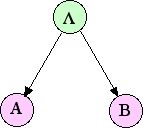Template:NumBlk
| 此模板使用Lua语言: |
此模板可用于编号数学公式與化學式。可和{{EquationRef}}同时使用,用于加入来源引用。
警告:當此模板與前導冒號:、前導星號*或前導井字號#一起使用時,可能會導致lint錯誤(英文說明)。更多資訊,請參閱§ 透過參數|2=以外的方式做縮排、§ 無序清單和§ 有序清單。
参数[编辑]
参数|1=、|2=和|3=是必须的。另外还有可选参数|RawN=、|LnSty=和|Border=。
|1=:设置缩进。使用冒号:。|2=:内容。|3=:编号。|RawN=:赋给一个非空字符串,移除编号和括号的格式。|LnSty=:设置线格式。|Border=:边框。
示例[编辑]
可生成HTML的公式[编辑] | ||||||||||
|---|---|---|---|---|---|---|---|---|---|---|
|
|
| |||||||||
|
|
| |||||||||
|
|
| |||||||||
|
|
| |||||||||
|
|
| |||||||||
缩进[编辑] | ||||||||||
|
|
| |||||||||
|
|
| |||||||||
|
|
| |||||||||
|
|
| |||||||||
公式编号格式[编辑] | ||||||||||
|
|
| |||||||||
|
|
| |||||||||
|
|
| |||||||||
|
|
| |||||||||
|
|
| |||||||||
|
|
| |||||||||
|
|
| |||||||||
线样式[编辑] | ||||||||||
|
|
| |||||||||
|
|
| |||||||||
|
|
| |||||||||
|
|
| |||||||||
|
|
| |||||||||
|
|
| |||||||||
|
|
| |||||||||
透過參數
| ||||||||||
以下的方程式
:<math>3x+2y-z=1</math>
::<math>2x-2y+4z=-2</math>
:::<math>-2x+y-2z=0</math>
形成三個方程式的方程組。
|
以下的方程式 形成三個方程式的方程組。 | |||||||||
以下的方程式
:{{NumBlk||<math>3x+2y-z=1</math>|1}}
::{{NumBlk||<math>2x-2y+4z=-2</math>|2}}
:::{{NumBlk||<math>-2x+y-2z=0</math>|3}}
形成三個方程式的方程組。
|
||||||||||
以下的方程式
<dl><dd>
{{NumBlk||<math>3x+2y-z=1</math>|1}}
<dl><dd>
{{NumBlk||<math>2x-2y+4z=-2</math>|2}}
<dl><dd>
{{NumBlk||<math>-2x+y-2z=0</math>|3}}
</dd></dl>
</dd></dl>
</dd></dl>
形成三個方程式的方程組。
|
以下的方程式
形成三個方程式的方程組。 | |||||||||
以下的方程式
<div style="margin-left: 1.6em;">
{{NumBlk||<math>3x+2y-z=1</math>|1}}
<div style="margin-left: 1.6em;">
{{NumBlk||<math>2x-2y+4z=-2</math>|2}}
<div style="margin-left: 1.6em;">
{{NumBlk||<math>-2x+y-2z=0</math>|3}}
</div>
</div>
</div>
形成三個方程式的方程組。
|
以下的方程式
形成三個方程式的方程組。 | |||||||||
以下的方程式
<div style="margin-left: calc(1.6em * 1);">
{{NumBlk||<math>3x+2y-z=1</math>|1}}
</div>
<div style="margin-left: calc(1.6em * 2);">
{{NumBlk||<math>2x-2y+4z=-2</math>|2}}
</div>
<div style="margin-left: calc(1.6em * 3);">
{{NumBlk||<math>-2x+y-2z=0</math>|3}}
</div>
形成三個方程式的方程組。
|
以下的方程式
形成三個方程式的方程組。 | |||||||||
無序清單[编辑] | ||||||||||
* <math>3x+2y-z=1</math>
* <math>2x-2y+4z=-2</math>
* <math>-2x+y-2z=0</math>
|
| |||||||||
* {{NumBlk||<math>3x+2y-z=1</math>|1}}
* {{NumBlk||<math>2x-2y+4z=-2</math>|2}}
* {{NumBlk||<math>-2x+y-2z=0</math>|3}}
|
||||||||||
{{Bulleted list
|1=<div style="display: inline-block; width: 100%; vertical-align: middle;">{{NumBlk||<math>3x+2y-z=1</math>|Eq. 1}}</div>
|2=<div style="display: inline-block; width: 100%; vertical-align: middle;">{{NumBlk||<math>2x-2y+4z=-2</math>|Eq. 2}}</div>
|3=<div style="display: inline-block; width: 100%; vertical-align: middle;">{{NumBlk||<math>-2x+y-2z=0</math>|Eq. 3}}</div>
}}
|
| |||||||||
{{Bulleted list
|1=<div style="display: inline-table; width: 100%; vertical-align: middle;">{{NumBlk||<math>3x+2y-z=1</math>|Eq. 1}}</div>
|2=<div style="display: inline-table; width: 100%; vertical-align: middle;">{{NumBlk||<math>2x-2y+4z=-2</math>|Eq. 2}}</div>
|3=<div style="display: inline-table; width: 100%; vertical-align: middle;">{{NumBlk||<math>-2x+y-2z=0</math>|Eq. 3}}</div>
}}
|
| |||||||||
有序清單[编辑] | ||||||||||
# <math>3x+2y-z=1</math>
# <math>2x-2y+4z=-2</math>
# <math>-2x+y-2z=0</math>
|
| |||||||||
# {{NumBlk||<math>3x+2y-z=1</math>|1}}
# {{NumBlk||<math>2x-2y+4z=-2</math>|2}}
# {{NumBlk||<math>-2x+y-2z=0</math>|3}}
|
||||||||||
{{Ordered list
|1=<div style="display: inline-block; width: 100%; vertical-align: middle;">{{NumBlk||<math>3x+2y-z=1</math>|Eq. 1}}</div>
|2=<div style="display: inline-block; width: 100%; vertical-align: middle;">{{NumBlk||<math>2x-2y+4z=-2</math>|Eq. 2}}</div>
|3=<div style="display: inline-block; width: 100%; vertical-align: middle;">{{NumBlk||<math>-2x+y-2z=0</math>|Eq. 3}}</div>
}}
|
| |||||||||
{{Ordered list
|1=<div style="display: inline-table; width: 100%; vertical-align: middle;">{{NumBlk||<math>3x+2y-z=1</math>|Eq. 1}}</div>
|2=<div style="display: inline-table; width: 100%; vertical-align: middle;">{{NumBlk||<math>2x-2y+4z=-2</math>|Eq. 2}}</div>
|3=<div style="display: inline-table; width: 100%; vertical-align: middle;">{{NumBlk||<math>-2x+y-2z=0</math>|Eq. 3}}</div>
}}
|
| |||||||||
边框[编辑] | ||||||||||
<!-- 未指定 LnSty -->
{{NumBlk|:|<math>y=ax+b</math>|Eq. 3|Border=1}}
|
| |||||||||
<!-- 指定 LnSty -->
{{NumBlk|:|<math>y=ax+b</math>|Eq. 3|LnSty=0.7em solid #e500e5|Border=1}}
|
| |||||||||
Positioning relative to surrounding images[编辑]
Numbered blocks should be able to be placed around images that take up space on the left or right side of the screen. To ensure numbered block has access to the entire line, consider using a {{clear}}-like template.
To illustrate, consider the example:
[[Image:Bnet_fan2.png|frame|right|Fig.1: Bayesian Network representation of Eq.(6)]]
[[Image:Bnet_fan2.png|frame|left|Fig.1: Bayesian Network representation of Eq.(6)]]
<br><br>A Bayesian network (or a belief network) is a probabilistic graphical model that represents a set of
variables and their probabilistic independencies. For example, a Bayesian network could represent the
probabilistic relationships between diseases and symptoms. Given symptoms, the network can be used to compute
the probabilities of the presence of various diseases.
{{NumBlk|1=:|2=<math>
P(a, b, \lambda) = P(a| \lambda) P(b | \lambda) P(\lambda)\,
</math>,|3='''Eq.(6)'''|RawN=.}}

A Bayesian network (or a belief network) is a probabilistic graphical model that represents a set of
variables and their probabilistic independencies. For example, a Bayesian network could represent the
probabilistic relationships between diseases and symptoms. Given symptoms, the network can be used to compute
the probabilities of the presence of various diseases.
| , | Eq.(6) |
If it is desirable for the numbered block to span the entire line, a {{clear}} should be placed before it.
[[Image:Bnet_fan2.png|frame|right|Fig.1: Bayesian Network representation of Eq.(6)]]
[[Image:Bnet_fan2.png|frame|left|Fig.1: Bayesian Network representation of Eq.(6)]]
<br><br>A Bayesian network (or a belief network) is a probabilistic graphical model that represents a set of
variables and their probabilistic independencies. For example, a Bayesian network could represent the
probabilistic relationships between diseases and symptoms. Given symptoms, the network can be used to compute
the probabilities of the presence of various diseases.
{{clear}}
{{NumBlk|1=:|2=<math>
P(a, b, \lambda) = P(a| \lambda) P(b | \lambda) P(\lambda)\,
</math>,|3='''Eq.(6)'''|RawN=.}}

A Bayesian network (or a belief network) is a probabilistic graphical model that represents a set of
variables and their probabilistic independencies. For example, a Bayesian network could represent the
probabilistic relationships between diseases and symptoms. Given symptoms, the network can be used to compute
the probabilities of the presence of various diseases.
| , | Eq.(6) |
Table caveat[编辑]
Because {{NumBlk}} is implemented as a table, putting {{NumBlk}} within a table yields a nested table. Due to a bug in Mediawiki's handling of nested tables, {{NumBlk}} must be used carefully in this case. In particular, when indentation for the outer table is desired, use explicit <dl><dd> and </dd></dl> tags for indentation instead of a leading colon (:).
For example,
<dl><dd>
{|
|<math>(f * g)[n]\,</math>
|{{NumBlk||<math>\stackrel{\mathrm{def}}{=}\sum_{m=-\infty}^{\infty} f[m]\cdot g[n - m]\,</math>|
3=<span style="color:darkred;">'''(Eq.1)'''</span>|RawN=.}}
|-
|
|<math>= \sum_{m=-\infty}^{\infty} f[n-m]\cdot g[m].\,</math> ([[Convolution#Commutativity|commutativity]])
|}
</dd></dl>
produces
-
(Eq.1) (commutativity)
which shows how the outer <dl><dd> and </dd></dl> tags give the same indentation as a single colon (:) preceding the table should.
For another example,
<dl><dd>
<dl><dd>
{|
|-
|The first parameter for indentation still works when used inside table.
{{NumBlk|::::|<math>ax^2+bx+c=0</math>|Level 4}}
{{NumBlk|:::|<math>ax^2+bx+c=0</math>|Level 3}}
{{NumBlk|::|<math>ax^2+bx+c=0</math>|Level 2}}
{{NumBlk|:|<math>ax^2+bx+c=0</math>|Level 1}}
{{NumBlk||<math>ax^2+bx+c=0</math>|Level 0}}
|-
|}
</dd></dl>
</dd></dl>
produces
-
-
The first parameter for indentation still works when used inside table. (Level 4) (Level 3) (Level 2) (Level 1) (Level 0)
-
which uses two sets of explicit tags to give the same indentation as two colons (::).
| 上述文档嵌入自Template:NumBlk/doc。 (编辑 | 历史) 编者可以在本模板的沙盒 (编辑 | 差异)和测试样例 (编辑)页面进行实验。 请在/doc子页面中添加分类。本模板的子页面。 |











![{\displaystyle (f*g)[n]\,}](https://wikimedia.org/api/rest_v1/media/math/render/svg/21b35630bbf1ce4962d17f232b71b4a746cd6c5a)
![{\displaystyle {\stackrel {\mathrm {def} }{=}}\sum _{m=-\infty }^{\infty }f[m]\cdot g[n-m]\,}](https://wikimedia.org/api/rest_v1/media/math/render/svg/341c36b82ecf37616a2c8547b22460162815d235)
![{\displaystyle =\sum _{m=-\infty }^{\infty }f[n-m]\cdot g[m].\,}](https://wikimedia.org/api/rest_v1/media/math/render/svg/fc8b45d23504b0d2ef575c406abe8e95c5e9c3b9)